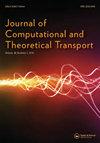三维自然对流的混合晶格玻尔兹曼模拟
IF 1.1
4区 工程技术
Q3 MATHEMATICS, APPLIED
Journal of Computational and Theoretical Transport
Pub Date : 2021-06-07
DOI:10.1080/23324309.2021.1942061
引用次数: 7
摘要
摘要研究了混合晶格玻尔兹曼-有限差分模型在层流和湍流三维自然对流模拟中的性能。采用点阵玻尔兹曼法计算流体力学,采用有限差分法求解平流扩散方程。研究发现,二维模型和三维模型再现了相同的热场。Nusselt数和Rayleigh数与基准数据吻合较好,所建立的混合模型的计算速度比传统计算流体力学(CFD)涡度-矢量势公式提高了2倍以上。本文章由计算机程序翻译,如有差异,请以英文原文为准。
Hybrid Lattice Boltzmann Simulation of Three-Dimensional Natural Convection
Abstract The capability of hybrid lattice Boltzmann–finite difference model in simulation of laminar and turbulent three-dimensional (3D) natural convection was examined. Fluid dynamics was computed by means of the lattice Boltzmann method and the finite difference solver was used for advection-diffusion equation. It was found that both two-dimensional and 3D models reproduced the same thermal fields. The Nusselt numbers were in a good agreement with benchmark data with the Rayleigh number up to Computation speed of developed hybrid model was more than two times higher in comparison with conventional computational fluid dynamics (CFD) vorticity–vector potential formulation.
求助全文
通过发布文献求助,成功后即可免费获取论文全文。
去求助
来源期刊

Journal of Computational and Theoretical Transport
Mathematics-Mathematical Physics
CiteScore
1.30
自引率
0.00%
发文量
15
期刊介绍:
Emphasizing computational methods and theoretical studies, this unique journal invites articles on neutral-particle transport, kinetic theory, radiative transfer, charged-particle transport, and macroscopic transport phenomena. In addition, the journal encourages articles on uncertainty quantification related to these fields. Offering a range of information and research methodologies unavailable elsewhere, Journal of Computational and Theoretical Transport brings together closely related mathematical concepts and techniques to encourage a productive, interdisciplinary exchange of ideas.
 求助内容:
求助内容: 应助结果提醒方式:
应助结果提醒方式:


